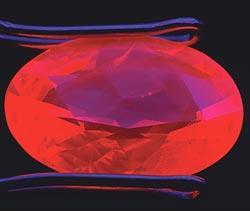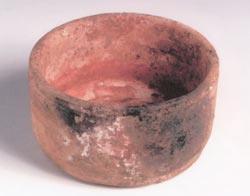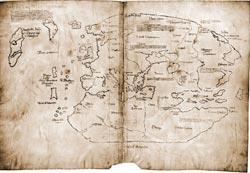Could a fire in a Roman villa alter the way we look at art forgeries? Who can tell you whether jewels on show at the Oscars are real? Helen Carmichael meets the detectives
Could a fire in a Roman villa alter the way we look at art forgeries? Who can tell you whether jewels on show at the Oscars are real? Helen Carmichael meets the detectives
Rare or historic jewels are generally sold at auction. A string of natural black pearls can fetch over $1 million (?600 000), so a certificate proving that they have not been enhanced in the laboratory provides a valuable means of authentication.
Lore Kiefert, director of the AGTA Gemmological Testing Centre (AGTA GTC) in New York, US, uses a range of analytical techniques to verify whether gems, and other precious natural materials such as corals and pearls, are genuine. Known as the gemstone industry’s Scotland Yard, the lab is a branch of the American Gem Trade Association (AGTA). The AGTA represents US and Canadian natural coloured gemstone and cultured pearl industry professionals, and lends gems to Hollywood stars for the Oscars.
There is no doubt that the jewels sparkling on the Oscar nominees are authentic. But at the AGTA GTC, experts examine suspect gemstones and keep abreast of the latest treatments used to enhance or fake natural pieces to sort rarities from wannabes. Gemstones created in the laboratory, or enhanced by heat or chemical treatments are fine, as long as this is stated openly. (Baking aquamarines to enhance their blue colouration or filling fissures in emeralds with waxes or resins are traditional procedures, and are generally accepted as standard practice.) Jewellers, museums and individual owners who want to know more can submit their gems to the AGTA GTC, or other specialist laboratories such as the UK Gem Testing Laboratory in London and the SSEF Swiss Gemmological Institute in Basel, Switzerland, for authentication.
Tricks of the trade
To alter their colour or clarity, gems can be bleached; coated with lacquer or enamel; dyed; heated, sometimes under pressure; irradiated with neutrons, gamma rays or beta particles; and treated chemically by diffusion. To toughen, add weight and hide surface or structural flaws, stones can be filled with glass, plastic or borax; surface treated with oil, wax or resin; and impregnated with plastics to toughen them or with waxes, paraffin or oil to boost the appearance of porous gemstones. The treatment varies depending on the class of gem.

To spot doctored gemstones, gemmologists use techniques that give specific information about the chemical composition, structure, bonding and impurities in each case. Fourier-transform infrared spectrophotometry (FTIR) can indicate heat treatment in corundums (aluminium oxide-based stones such as rubies and sapphires), show up evidence of fracture filling in emeralds, and help detect different types of diamond.
Raman spectrometry gives a unique fingerprint of the gemstone. ’Raman spectrometry is unique in identifying a mixture of various minerals as found in many ornamental stones,’ says Kiefert. Another advantage of Raman is that it can be applied to gemstones set in jewellery, where other methods, such as measuring a gem’s refractive index, won’t work.
In her previous job at the SSEF Swiss Gemmological Institute, Kiefert examined bejewelled gothic objects from the Basel Cathedral Treasury, with colleagues Henry H?nni and Sabine H?berli, using a portable Raman spectrometer. They found that a range of materials had been used in the 15th century monstrances, crosses and reliquaries, including gemstones, glasses and near colourless quartz and glass doublets, which were probably once filled with richly coloured pigments, long since faded.
The brilliant cuts of some of the gemstones are modern, and earlier cabochon-cut stones appear to have been replaced. Blue and red glass seems to have been a common substitute for sapphires and rubies. We will probably never know whether someone at the cathedral was funding renovations with a little help from the Treasury.
Tracing origins
Raman spectroscopy is also a useful non-destructive tool to investigate inclusions in gemstones, and has been used to spot the fillers used in treated emeralds, and treated diamonds. Gemmologists use library spectra from previously authenticated examples for comparison.
Kiefert uses spectra from the AGTA GTC’s UV-visible spectrophotometer to identify diamond treatments and heat treatment in coloured gemstones such as tourmaline, and in pearl identification. Ultraviolet spectra can help to determine the country of origin for rubies, sapphires and emeralds, and Kiefert also uses them when investigating the origin of colour in coloured diamonds.
X-ray fluorescence (XRF) can also be used to trace the origins of particular rubies, sapphires and emeralds. ’We would use XRF to identify chemical composition,’ says Kiefert. ’We investigate the elements present, which tells us whether the material is natural or synthetic: in many cases the composition is specific to the source.’
Of around 2,500 types of coral living in our seas, only a handful of varieties are used in jewellery. ’Today lower-quality coral is dyed or treated with resin, and it can also be imitated using glass or dyed shell beads,’ Kiefert says. If the material has been dyed this is often obvious: a tell-tale white drill hole through the bead or on the inside when cracked open are a dead giveaway. ’Raman spectroscopy is a good technique to use if you cannot break a bead open,’ Kiefert says. Raman is generally used if microscopy does not give sufficient clues about the coral.
Calcium carbonate grown by sea creatures comes in two forms: calcite and aragonite. Spotting beads faked from dyed shell to look like coral is fairly straightforward, because aragonite peaks can clearly be seen on the Raman spectra, as can artificial and natural dyes. Real coral is made of calcite.
When a natural pearl is x-rayed, its shadow image shows the internal concentric structure that is formed by layers of aragonite, deposited as the pearl is formed. ’Cultured saltwater pearls generally contain a bead made from the mother-of-pearl of a freshwater mussel,’ Kiefert explains. ’Beads of this type show a lighter concentric feature surrounded by a slightly darker layer. ’Cultured freshwater pearls do not contain a bead, but they often have an irregular centre,’ says Kiefert. ’Freshwater pearls always contain a trace amount of manganese, which is not found in saltwater pearls.’ Kiefert uses XRF to detect whether manganese is present, and so check whether the pearls formed in a fresh water or saltwater environment.
Pearls of wisdom
The old trick of detecting imitation pearls from the natural or cultured varieties by rubbing them against your teeth does work: ’I wouldn’t take a necklace that somebody else has worn around the neck in my mouth, but it is true,’ Kiefert says. ’You can also determine it by rubbing two pearls of the necklace against each other. The imitations feel very smooth, whereas natural or cultured pearls have a little bit of resistance.’ Under the microscope the reason for this is clear: the imitation has a glassy surface while the platelets of aragonite on the real pearl give a rough finish.
Natural black pearls are rarer than white pearls, and black pearls from the Gulf of California have been valued since the Spanish arrived in the New World. Cultured black pearls are also produced in the Gulf of California and in Tahiti. Natural black pearls are not widely available, appearing only at specialist auctions, where they are sold for a small fortune. Fakers have been treating paler pearls with silver nitrate since the 1930s to pass them off as black ones. This practice continues, but Kiefert says that other methods including irradiation and using organic dyes have also emerged.
Silver nitrate-treated pearls are easy to spot, either by close examination of the bead’s drill hole, or using x-ray or XRF to detect the silver. Pearls have some natural features that show up in their Raman spectra: white pearls give a distinctive aragonite signature, but black pearls have weaker aragonite bands together with bands caused by organic material and increasing fluorescence towards higher wavenumbers when using a 514.5nm laser. (The stronger bands make the aragonite signal appear smaller by comparison.) The coloured pigment porphyrin has been identified as one of the organic components, and conchiolin is also likely to be present.
These features are useful because artificially blackened pearls have the distinct aragonite peaks in their Raman spectra that give away their original white colour. Irradiated cultured pearls do have a small aragonite feature more in keeping with a natural black pearl, but the telltale porphyrin bands associated with genuine black pearls, found between 1100 cm-1 and 1800 cm-1, are missing.
A significant part of the AGTA GTC’s work is to keep up with the latest tricks used by those passing off lesser gems as rarities, and alerting others in the gem trade to these developments. ’We are always a few steps behind,’ Kiefert acknowledges, ’sometimes many steps’. Artificially coloured yellow pearls are now on the market made by irradiating or heating white or off-white pearls in conjunction with a dye, and the treatment is rarely detected.
Roman decorators
Analytical techniques can also be used to detect modern substances in seemingly ancient works. One such substance is anatase - a form of titanium dioxide used as a pigment.

Anatase is widely considered to be a calling card from ill-informed forgers, because it was first available in its pure white form in the early 1920s. Raman spectroscopy is increasingly popular as an analytical technique, and anatase gives a very strong signal, so is hard to miss. When analysts discover that documents and artworks contain anatase, hopes of authenticating the item quickly fade.
At the 3rd international conference on the application of Raman spectroscopy in art and archaeology in Paris in September last year, a new chapter in the anatase story was under discussion: not in the main auditorium, but over lunch. Paul Middleton, an archaeologist from Peterborough Regional College, UK, was talking to collaborator Howell Edwards, an expert in chemical and forensic sciences from the University of Bradford, UK, about the results from a number of UK excavations. Their Raman analysis of painted plaster and pigment from a Romano-British villa at Easton Maudit and a ceramic paint vessel from a Romano-British workshop at Castor showed that anatase had been present in both cases. How did it get there?
Evidence at the Easton site suggests that the villa, probably constructed in the first century AD, was undergoing late second century AD renovation when a group of paint pots was smashed on the cellar floor. These, along with plaster taken from the main villa, were the source of most of the samples. However, the Roman makeover seems to have been cut short abruptly by a fire. Debris falling during the blaze sealed the paint pots in the cellar, until they were discovered many centuries later by archaeologists. The complete pottery vessel, from Castor, was excavated in 1969 by G B Dannell and J P Wild.
Both archaeological sites were secure, so it will be hard to argue that the samples were contaminated. ’We think the anatase was a component of a pigment additive, which may have been clay-based,’ Edwards told Chemistry World.
Why was this material added to the paint? ’Its hiding power and reflective qualities would have undoubtedly enhanced the surface finish of any wall covering,’ say Edwards and Middleton. Another property of the clay-based additive may have been to help the paint stick better to the walls.
Although anatase is rare, it does occur naturally in the UK, especially in Wales, Devon and Cornwall. It is associated with kaolin or china clays. Could anatase have been used deliberately in antiquity? Middleton and Edwards agree that there is a strong possibility that Roman decorators were incorporating British materials into their paint mixtures.
The Roman anatase crystals were in their natural form showing a broad range of crystal sizes with angular shapes rather than the manufactured pure white, rounded crystals of uniform size used in modern paints. It therefore seems most likely that the anatase was an intrinsic part of the paint additive rather than the product of intentional Roman separation techniques: further samples of paint taken from the walls of a number of villas are now being investigated. The details can be found in a forthcoming article in Analytical and Bioanalytical Chemistry.
Scientific evidence
It seems unlikely that confirmed forgeries will be dusted off and resubmitted for authentication in the light of such findings, although a few anomalous readings could be explained. Anatase has been noted in other artefacts, including ancient Chinese porcelains. A closer look at the anatase crystals and the other materials present could yield valuable information, and add to the evidence available to archaeologists and curators.
When it comes to forgeries and fakes, considerable sums of money, and reputations, are at stake. University of Greenwich, UK, art analyst Robert Withnall says that incorporating fresh scientific evidence can be tricky: ’Galleries and museums may have spent large sums on an acquisition, or the possibility that an object is a fake or forgery may question a philosophy: eg religious in the case of the Turin shroud, or historical in the case of the Vinland map [see box on p37].’ Even in the face of overwhelming scientific evidence, Withnall says that the case is seldom closed. ’The opposition has something to lose if it is disclosed that an object is definitely not authentic.’
Helen Carmichael is a freelance writer based in Dorset, UK.
Further Reading
- H G M Edwards and J M Chalmers (eds), Raman Spectroscopy in archaeology and art history, 2005, RSC, Cambridge UK
- H G M Edwards et al, Anal. Bioanal. Chem., in press
- P S Middleton et al, Proceedings of the sixth infrared and Raman users group conference, 2004, Il Prato
The Vinland verdict
The Vinland map is the earliest known representation of any part of the New World and it originated in northern Europe during the 15th century.or it’s a modern forgery, depending on which evidence you find most compelling. The map has historical significance because radiocarbon dating of the parchment places it around 50 years before Columbus arrived in the New World. Some have speculated that a forger obtained a 15th century manuscript on which to carry out modern work.

Proponents of the map’s authenticity such as Jacqueline Olin from the Smithsonian Institution in Washington DC, US, have attempted to explain the presence of anatase detected by Raman spectroscopy in some of the inks. Its detractors, including Kenneth Towe, also of the Smithsonian, and Robin Clark at University College London, UK, are certain that the inks are inconsistent with the era.
According to Olin, the mineral form of anatase (octahedrite) occurs naturally, while material precipitated from the mineral ilmenite characterises anatase first produced commercially in the 20th century. She is keen to challenge the 20th century limitation on anatase, however: ’I produced precipitated anatase in the laboratory using ilmenite and sulfuric acid in an experiment to demonstrate that ink containing anatase could have occurred before the 20th century,’ Olin told Chemistry World.
Kenneth Towe also highlights the distinction between the natural and the commercially-produced material. He told Chemistry World that the anatase in the Vinland ink has a commercial fingerprint: it has a narrow crystallite size distribution, the crystals are not angular, and the anatase is not accompanied by any clay minerals, ruling out natural sediments such as kaolin clay as a potential source. Natural material that had been ground up would have a broad size distribution among its crystals, as well as angular crystal morphologies. Any theory suggesting a medieval cartographer had ground up natural pigments from a clay source to make ink to use on the Vinland map just won’t hold up, Towe says.
Much of the recent argument has been carried out on the pages of Analytical Chemistry, and while neither side has conceded defeat, those who think the anatase on the map shows that it is a modern forgery currently have the upper hand. Yale University paid $1million (?575000) for the map in 1957, and would no doubt still welcome any further evidence that its purchase was authentic.
Further analyses of other mediaeval documents might shed some light on the origins of the troublesome ink. But Clark suggests that detailed Raman studies over the 12 years to 2004 of over 20 large Anglo-Saxon and European manuscripts and codices dating from 700 to 1500 AD have failed to find anatase inks. Known to be an intense Raman scatterer, anatase should be hard to miss in Raman studies.
Further reading
- J S Olin, Anal. Chem., 2003, 75, 6745
- K M Towe, Anal. Chem., 2004, 76, 863
- R J H Clark, Anal. Chem., 2004, 76, 2423






No comments yet